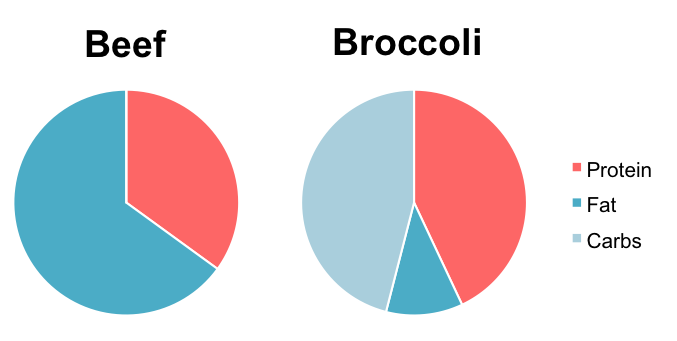Tips for Making Sense of Conflicting Nutritional Claims

Why is the world of nutrition so full of conflicting and confusing advice?
Part of the problem is that even a simple question can be answered many different ways, giving conflicting answers.
This article is a two-for: we answer a ?simple? question about protein content, and we learn how to be more critical consumers of nutrition information.
Question: Which has more protein, broccoli or beef?
Plant-based eaters claim that broccoli is superior to beef for protein content. Meat-eaters have balked. Who is right?
Answer: It depends.
It depends on which method you choose for your comparison, as well as on which cut of beef you choose.
Five Ways to Compare Protein Content
- Percent of calories (calories from protein divided by total calories)
- Calorie-matched servings (e.g grams protein per 100 calories)
- Mass-matched servings (e.g. grams of protein per 100 grams)
- Volume-matched servings (e.g. grams of protein per cup)
- ?Typical? serving size (e.g. grams or protein per random serving size, not necessarily the same for the two foods)
Which Cut of Beef?
I based my analysis on ground beef, because it is the most commonly consumed type of beef in North America. Within ground beef, I opted for 85% lean (on the leaner side of the most common ground beef cuts).
Show Me the Data!
The chart below shows my findings, with each row displaying a different method:
 Different ways to compare protein content of broccoli vs ground beef. Data from USDA.
Different ways to compare protein content of broccoli vs ground beef. Data from USDA.
*Amount of ground beef per cup based on this tool.**For serving size, I chose 2 cups of broccoli and 120 grams / 4 oz of beef.
And the Winner Is?
Broccoli ?wins? according to percent of calories from protein and grams of protein per 100 calorie serving. Ground beef ?wins? using servings of 100 grams, one cup or a ?typical? serving size .
If I had chosen 81% lean ground beef (the most common cut), broccoli would have ?won? by a larger margin on the calorie-based metrics. If I had chosen a leaner cut of beef (upwards of 90% lean), beef would have won across the board.
Which Method is Best?
The right method depends on the intent of your question.
If you are wondering which food on your dinner plate has more protein, then you should be using the portion sizes on your plate.
In most other cases, I recommend using calorie-based metrics (either percent of calories from protein, or calorie-matched comparison).
The Case for Calorie-Based Comparisons
Using percent-calories or calorie-matched methods has several advantages:
- They avoid the need to choose arbitrary serving sizes (my broccoli serving is probably much larger than yours!)
- They are not impacted by water and fiber content. Foods high in water or fiber will always score lower when you compare servings by weight or size. It?s no surprise that a cup of nuts has far more protein than a cup of spinach ? spinach is mostly water (only 7 calories per cup!)
- Last but not least, these methods put the protein content in context. They tell us the nutritional contribution of protein relative to other macronutrients. If all the calories in a food make up a pie, these methods tells us how big the protein slice is (versus the fat and carbohydrate). See image below:

Introducing the Broccolivore
It can be a useful thought exercise to take things to the extreme. How well nourished would you be if all you ate were broccoli? Or only ground beef?
Guess what?
If all you ate were broccoli, you would end up eating more protein than if you were a ground-beef-only carnivore!
Let?s assume you ate 2,000 calories in either case (the national recommended daily intake averaged between adult men and women). For broccoli, this translates to 220 grams of protein (20 x 11 grams per 100 calories). For ground beef, this means 180 grams of protein (20 x 9 grams per 100 calories).
I?m not actually recommending a broccoli-only diet, I?m simply pointing out that if you took this to the extreme, broccoli would ?win? against ground beef. This is because the broccoli?s protein piece of the calorie pie is larger than ground beef?s piece.
This may sound like theoretical nonsense but you?d be surprised what people will do. All-meat diets (carnivorism) are on the rise?perhaps there will be an all-broccoli diet coming soon!
The Bottom Line
As an information consumer, you should look for advice that:
- Provides reputable data sources.
- Provides clear methods behind the findings.
- Provides a rationale for the choice of method (icing on the cake!).
Nutritional ?experts? should be creating clarity not confusion. May the clearest, most rational voice win, rather than the loudest!
Future Directions
It saddens me that the public has become so disenchanted with nutritional research that they are ready to throw up their arms (or have already) and ignore it. What can we do so that we don?t throw out the baby with the bathwater?
A big part of my mission with Fueled by Science is to equip non-scientists to become more critical consumers of health and nutrition research.
This article speaks to one small piece of the nutritional confusion puzzle ? the impact that choice of methods and data sources have on your findings. There are many other pieces of the puzzle, from the complex underlying science, to limitations in the tools we have to study human nutrition, but those are for another time!
Learn more at Fueledbyscience.com
Limitations and Caveats
- This analysis does not take into account differences in protein absorption. In general, these tend to be lower with plant-based proteins, but not by a large enough margin to change the overall findings.
- This analysis does not look at the specific essential amino acids contained in broccoli versus beef. I cover this topic in my mythbuster article below on the ?completeness? of plant-based proteins.
Related Articles
- Busting the Myth of Incomplete Plant-Based Proteins ? compares protein quality between plant and animal proteins.
- Your Child May Not Need as Much Protein as You Think ? shows you how to calculate your child?s protein needs ( in grams and percent of calories)
Data Sources
- Data on beef consumption from: US Department of Agriculture ? for example: https://www.ams.usda.gov/mnreports/lm_xb459.txt
- Broccoli: USDA Nutritional Database entry 11740 (Broccoli, flower clusters, raw)
- Ground Beef: USDA Nutritional Database entry 23567 (Beef, ground, 85% lean meat / 15% fat, raw)


